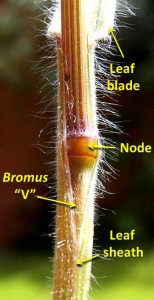After posting the two large tribes (Poeae and Aveneae) Dr M is pleased to post this smaller (but perfectly proportioned) tribe Bromeae, the Brome grasses!
The Brome grasses are extremely beautiful grasses with rather characteristic oval and awned spikelets, though the main Bromeae genus, Bromus, is rather close to Festuca, read on!
The inflorescence is a panicle with laterally compressed spikelets with several to many fertile florets and usually with imperfect (poorly formed and/or sterile) florets in the upper part.
The glumes are persistent and shorter than lowest lemma. The lemmas are herbaceous to coriaceous 5-13 nerved, 2-toothed at tip, with a straight or recurved sub-apical awn.
The ovary is capped by a hairy lobed appendage bearing sub-terminal stigmas, this is an important diagnostic feature (see below).
In Bromeae, most species are concentrated in one large genus, Bromus, which grows in a wide range of mesotrophic habitats in the temperate zone. The book of Stace divides the UK species of Bromeae into four main genera Anisantha, Bromopsis, Bromus and Ceratochloa, but Cope & Gray (2009) find little to commend this approach and they retain the single genus Bromus and retain the the other names to define the sections. Dr M follows their example here.
The Bromeae tribe is very similar to the Poeae and to Triticeae tribes, and its claim to tribal status rests mainly on its unusual starch grains in the endosperm which are of a simple rounded form (very different to the compound or angular grains of most other members of the Poaceae).
The tribe is not always easily separated from Poeae (the starch grains are not a practical diagnostic feature, certainly not in the field!). One of the most useful diagnostic features is the ovary appendage – visible even in young specimens.
Vegetatively, the genus is characterised by a leaf sheath which is open at the apex and then with connate margins for the remainder of its length. This arrangement results in a “V” shape adjacent to the junction of the leaf blade and sheath. Dr M was first shown this by a Czech botanist some years ago refers to this as the “Bromus V-neck” – which can be a rather helpful field character!
- Bromus hordeaceus ssp. hordeaceus
- Bromus hordeaceus ssp. ferronii
- Bromus sterilis
- Bromus hordeaceus spikelet
- The grass seed – caryopsis
- Bromus ramosus – auricles
Click on the images for a better view.
Here are details of four common Bromus species (and a less common sub-species!):
Bromus sterilis (syn. Anisantha sterilis; Barren Brome (the name “barren” referring to the low agricultural yield not sterility – this is a highly fertile grass!). Annual, panicle with long stalked, spikelets and drooping branches up to 10 long. Spikelets oblong and 25-36 mm long (excluding awns), 4-12 flowered. Lower glume 1-nerved, lemma coarsely scabrid on the back, awn 20-35 mm long. Ligule jagged and rounded 1.5-3.5 mm long. A very common weed of arable land and a wide range disturbed places, roadsides, waste ground and hedgerows.
Bromus hordeaceus (Soft Brome). Annual, panicle loose at first, nodding at maturity. Spikelets ovate to oblong and 10-20 mm long (excl. awns), 5-13 flowered. Lower glume 3-nerved pubescent, lemmas papery and pubescent, awn 6-10 mm long. Ligule blunt 0.4-1.8 mm long. This is a hugely variable grass found in a wide range of open, grassy habitats including hay meadows, sown pastures, lawns and roadside verges, and in disturbed man-made habitats such as arable fields and waste ground, also coastal habitats such as sand dunes and shingle beaches and coastal cliffs (B.hordeaceus ssp. ferronii also occurs on coastal cliffs and has stiff erect panicles and outwardly curving awns).
Bromus erectus (syn. Bromopsis erecta; Upright Brome). Densely tufted perennial with short rhizomes, panicle erect, loose to dense with short scabrid branches. Spikelets lanceolate to oblong and 20-35 mm long (excl. awns), 4-10 flowered. Lower glume 1-3 nerved, lemma 7 nerved, scaberulous to softly hairy, awn 4-7.5 mm long. Leaf blade with characteristic “eye-lash hairs” projecting at 45 degrees to the leaf margin, ligule blunt 0.5-2 mm long. Common in calcareous grassland (on chalk and other limestones throughout Britain) and most abundant (even dominant) where grazing is relaxed or absent.
Bromus ramosus (Bromopsis ramosa; Hairy Brome). A tall, elegant tufted perennial with erect culms up to 2 m tall. Panicle large and often drooping to one side. Spikelets are lanceolate to oblong and 15-40 mm long, 3-12 flowered. Lower glume 1-nerved, lemma 5-nerved and pubescent near the margins, scabrid on the back, awn 5-9.5 mm long. The leaf blades bear short pointed auricles which are diagnostic and the ligule is blunt and 1-4.5 mm long. Frequent in woodland margins and hedgerows on moist base rich soils.
What a lovely tribe!
Next tribe is Triticeae including all those wild relatives of the crop cereals wheat and barley, yummy!








